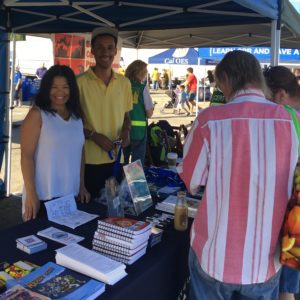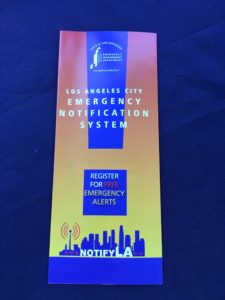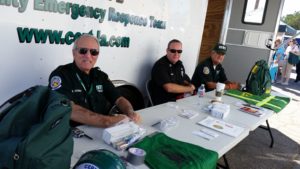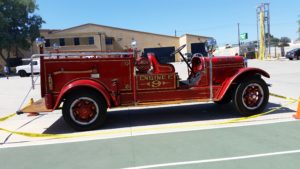 Over 3,000 people, including 1,000 families, attended the 9th Annual Valley Disaster Preparedness Fair held Saturday, October 1, 2016 at Fire Station 87 in Granada Hills. The all-day event drew together emergency preparedness professionals and reps from nearly 70 neighborhood councils in Los Angeles. The purpose of the Valley Disaster Preparedness Fair was to help equip the public in better preparing their families, their pets, and their communities for a major emergency or disaster by offering vital information about and demonstrations of life-saving safety techniques.
Over 3,000 people, including 1,000 families, attended the 9th Annual Valley Disaster Preparedness Fair held Saturday, October 1, 2016 at Fire Station 87 in Granada Hills. The all-day event drew together emergency preparedness professionals and reps from nearly 70 neighborhood councils in Los Angeles. The purpose of the Valley Disaster Preparedness Fair was to help equip the public in better preparing their families, their pets, and their communities for a major emergency or disaster by offering vital information about and demonstrations of life-saving safety techniques.
“The first 60 minutes after a disaster are critical,” notes Bill Hopkins, chair of the Valley Disaster Preparedness Team and president of the Southern California Preparedness Foundation, which organized the Disaster Preparedness Fair. “In a wide-spread disaster, it may be days or weeks before emergency personnel can come to your aid. A prepared community can minimize property damage, save lives, reduce the severity of injury, and provide aid to those who need it when roads are inaccessible and emergency assistance is unavailable.”
According to the California Earthquake Authority, almost everyone who lives in California lives within 15 miles of an active earthquake fault. This is why California is called ‘Earthquake Country.” In the event of a major catastrophic earthquake, like experts predict we will see, roads will be impassable, power will be lost, and food supplies will be scarce. Emergency personnel will be unable to reach victims for days after a largescale disaster, so it is imperative that everyone who can prepare in advance, does so, so that they can help themselves. Unfortunately, many people are ignoring the warnings, says Mona Curry, Emergency Manager for the Valley Bureau, City of L.A. Emergency Management Department.
“A lot of people don’t take it seriously; they think it won’t happen to them. Unlike the East Coast, which is hit with disaster after disaster, we haven’t had a lot of disasters in Southern California and people have become complacent about planning for disasters. It’s like we’re trying to convince them that they need to prepare.”
She adds, “If you don’t want to count on everyone else for your well-being, you need to have a plan and understand that help may not come to you like you think it will and you can’t rely on others to help you. You have to be able to take care of yourself. We are trying to get people to understand that we have a threat of a big earthquake, something like we’ve never seen before, and it may very well happen — and soon.”
To better prepare, L.A. residents can sign up for NotifyLA, an emergency alert system that sends messages to your cell phone or email in the event of a local or regional event. This free service will tell you, when you are away from your home, what to expect when you return if something serious is happening in your neighborhood. (To sign up for NotifyLA, go to: http://emergency.lacity.org/notifyla).
Additionally, Curry recommends each family participate in the 5 Steps to Neighborhood Preparedness Plan (http://5steps.la). This simple plan walks you through the planning process of getting to know your immediate neighbors on a block or in a housing complex, so that everyone is ready to help one another when needed. In addition to introducing neighbors to one another in a series of positive interactions, it provides advance notice of who has special skills and knowledge, who needs extra help, and who has pets that might need assistance if there was a fire, earthquake, flood, or any other type of disaster.
At the October 1st Disaster Preparedness Fair, over 60 vendors were on hand to share information, such as the County of L.A.’s Emergency Survival Guide with 96 pages of helpful information for preppers; the California Earthquake Authority’s Country Alliance “7 Steps to Earthquake Safety,” and the American Red Cross’s preparedness tips: 21 Weeks to Prepare. To accommodate the crowds at the half-day event, volunteers cooked 2,300 meals, provided for free, due to the events’ sponsors. Major sponsors included: L.A. County Supervisor Michael Antonovich, Patriot Oil Community Benefits Trust Fund administered by the North Valley Coalition, and a number of City of L.A. Neighborhood Councils who donated money from their yearly budget for this event.
“Having the Neighborhood Councils on board with this effort was a great way to highlight their importance to our residents in Los Angeles,” says Hopkins. “These volunteers are usually the first point of contact on issues that concern quality of life for our residents and they do so without pay.”
There were also four, half hour informational presentations from: MySafe:LA, Education Manager Chris Nevel; Louise Masin Sattler, a trainer for first responders on how to help people with special needs (www.SigningFamilies.com); Lake Balboa NC Member Brian Tessier who shared how to how to put together an emergency preparedness kit “on the cheap”; Gracyce Liu, General Manager of EmpowerLA, who encouraged neighborhood councils to help their communities with emergency preparedness; and Red Cross Instructor Erin Huey, who talked about pet safety and pet preparedness.
 To further instruct pet owners on planning ahead for their animals’ needs, the Southern California Preparedness Foundation’s Animal Response & Rescue Coalition shared information on: how to plan for the welfare of your pets if you have to leave your home, what food and other items to stockpile if you are stuck in your home for days or weeks, and what documents to have copies of – should you need them.
To further instruct pet owners on planning ahead for their animals’ needs, the Southern California Preparedness Foundation’s Animal Response & Rescue Coalition shared information on: how to plan for the welfare of your pets if you have to leave your home, what food and other items to stockpile if you are stuck in your home for days or weeks, and what documents to have copies of – should you need them.
To help attendees prepare for what may come our way, 1,200 people got bags stuffed with free giveaways and emergency preparedness information, which Hopkins estimates, was a $75.00 value. The items included: emergency water, work gloves, emergency goggles, face masks, a first aid kit, a 3-in-1 can opener, an emergency blanket, a flashlight, safety light stick, whistle, and key chains with red flashing lights to make it easy for rescuers to find a person at night.
Onsite, Cedars-Sinai ran a bloodmobile donation center while those who were more daring, the “Shakey-Quakey” mobile vehicle simulated an earthquake occurrence.
This was the second year that the Annual Disaster Preparedness Event was put on by Hopkins’ nonprofit, the Southern California Preparedness Foundation. Previously, the City put on the event, but due to budget cuts, they now participate as sponsors.
In addition to the Disaster Preparedness Event, Southern California Preparedness Foundation serves the public with the “Map Your Neighborhood Program,” which helps neighbors learn what skills or disabilities their neighbors might have in the event of an emergency. Hopkins’ says their long range plan is to facilitate the City’s CERT Program by providing personal protective equipment to first responders and CERT graduates.
emergency. Hopkins’ says their long range plan is to facilitate the City’s CERT Program by providing personal protective equipment to first responders and CERT graduates.
“I feel very proud of our Valley Disaster Preparedness Team,” says Hopkins. “This is an event we couldn’t do alone. It was a highly successful, family – friendly event and totally free to everyone who attended. The key thing is that we gave away over 1,200 family emergency starter kits and many people were introduced, for the first time, to a lot of resources and free supplies to put in their kits and hopefully, be better prepared now.”
For more information, go to: www.socalprep.us or www.valleydisasterfair.com.
